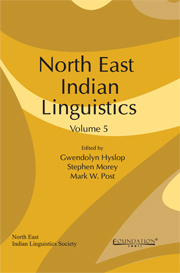Foreword
Published online by Cambridge University Press: 05 September 2013
Summary
It goes without saying that North East India is one of the most attractive areas on earth in terms of linguistic endeavors. Like its biological diversity, it is a homeland of various ethnic peoples and tribes, as well as their languages, belonging to four broadly-recognized families: Tibeto-Burman, Indo-Aryan, Austro-Asiatic and Tai-Kadai. For the last few decades, western scholars and local Indian scholars have been working on many languages in North East India. Although I am a newcomer in the field of North East Indian Linguistics, I find much research into various languages in the region to be very successful, not to mention the award-winning Grammar of Galo by Mark W. Post. In this sense, I believe that NEILS, where various scholars get together, whether they are highly-accomplished senior scholars or students, provides an excellent forum for presenting the outcomes of linguistic endeavors by foreign and local scholars who work on North East Indian languages, and that it brings a good chemistry to the field. In past NEILS conferences, some Japanese scholars (myself included) participated as well. However, currently there is a relatively small population of Japanese scholars who work on North East Indian languages.
Since the advent of Buddhism in Japan in the eighth century, Sanskrit has been the most studied Indian languages in Japan. In the context of Buddhism, Tibetan and Burmese are also actively studied in Japan. Alongside studies of these two languages, other Tibeto-Burman languages are studied as well, especially those spoken in China and Myanmar.
- Type
- Chapter
- Information
- North East Indian Linguistics , pp. ix - xiiPublisher: Foundation BooksPrint publication year: 2013



